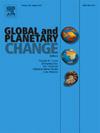The restoration of karst rocky desertification has enhanced the carbon sequestration capacity of the ecosystem in southern China
IF 4
1区 地球科学
Q1 GEOGRAPHY, PHYSICAL
引用次数: 0
Abstract
The control of rocky desertification is the largest ecological restoration project in southwestern China, but its impact on the carbon sequestration capacity of karst ecosystems is not clear. Therefore, in this paper selects typical subtropical karst areas in Guangxi are selected as the research object, the carbon sequestration potential of the terrestrial ecosystems are quantified, including karst inorganic carbon sinks, and the response of the terrestrial ecosystem carbon sink to rocky desertification restorationis discussed. The results show that (1) the karst inorganic carbon sink flux (CCSF) is 42.75 t CO2/km2/yr, with a total CCS of 491.12 × 104 t CO2, accounting for only 2.5 % of the country's land area and contributing 7.6 % of the karst inorganic carbon sink. (2) The flux of the vegetation organic carbon sink is 380.44 t CO2/km2/yr, and the total amount is 4403.55 × 104 t CO2/yr., Overall, the spatial distribution exhibits a pattern of high in the northwest and low in the northeast. (3) With decreasing rocky desertification area, the magnitude of the terrestrial ecosystem carbon sink has exhibited a corresponding increasing trend. In particular, during 2010–2020, the rocky desertification area decreased by about 0.868 × 104 km2, and the terrestrial ecosystem carbon sink increased by 114.04 t CO2/km2/yr. This article provides a systematic spatial diagnosis of the carbon sequestration potential of terrestrial ecosystems, including karst inorganic carbon sinks, in the karst areas of Guangxi, and reveals their responses to the restoration of karst rocky desertification. This work has strong reference value and significance for the diagnosis and analysis of the carbon neutrality capacity at the national and global levels.
喀斯特石漠化的恢复提高了中国南方生态系统的固碳能力
石漠化治理是中国西南地区最大的生态修复工程,但其对岩溶生态系统固碳能力的影响尚不明确。因此,本文选择广西典型的亚热带岩溶地区作为研究对象,量化了包括岩溶无机碳汇在内的陆地生态系统固碳潜力,并讨论了陆地生态系统碳汇对石漠化修复的响应。结果表明:(1)岩溶无机碳汇通量(CCSF)为 42.75 吨二氧化碳/平方公里/年,CCS总量为 491.12×104 吨二氧化碳,仅占全国陆地面积的 2.5%,对岩溶无机碳汇的贡献率为 7.6%;(2)植被有机碳汇通量为 380.44 吨二氧化碳/平方公里/年,总量为 4403.55×104 吨二氧化碳/年、总体而言,空间分布呈现西北高、东北低的格局。(3)随着石漠化面积的减少,陆地生态系统碳汇的增加也呈现出相应的增加趋势。其中,2010-2020年间,石漠化面积减少了约0.868×104 km2,陆地生态系统碳汇增加了114.04 t CO2/km2/yr。本文对广西岩溶地区包括岩溶无机碳汇在内的陆地生态系统固碳潜力进行了系统的空间诊断,并揭示了其对岩溶石漠化恢复的响应。这项工作对全国乃至全球碳中和能力的诊断和分析具有很强的参考价值和借鉴意义。
本文章由计算机程序翻译,如有差异,请以英文原文为准。
求助全文
约1分钟内获得全文
求助全文
来源期刊

Global and Planetary Change
地学天文-地球科学综合
CiteScore
7.40
自引率
10.30%
发文量
226
审稿时长
63 days
期刊介绍:
The objective of the journal Global and Planetary Change is to provide a multi-disciplinary overview of the processes taking place in the Earth System and involved in planetary change over time. The journal focuses on records of the past and current state of the earth system, and future scenarios , and their link to global environmental change. Regional or process-oriented studies are welcome if they discuss global implications. Topics include, but are not limited to, changes in the dynamics and composition of the atmosphere, oceans and cryosphere, as well as climate change, sea level variation, observations/modelling of Earth processes from deep to (near-)surface and their coupling, global ecology, biogeography and the resilience/thresholds in ecosystems.
Key criteria for the consideration of manuscripts are (a) the relevance for the global scientific community and/or (b) the wider implications for global scale problems, preferably combined with (c) having a significance beyond a single discipline. A clear focus on key processes associated with planetary scale change is strongly encouraged.
Manuscripts can be submitted as either research contributions or as a review article. Every effort should be made towards the presentation of research outcomes in an understandable way for a broad readership.
 求助内容:
求助内容: 应助结果提醒方式:
应助结果提醒方式:


